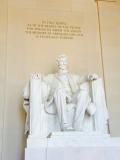Friday, May 29, 2015
By:
Woohoo! First week in D.C.! This week has been surreal. I met a Nobel Laureate, talked with members of the SPS leadership, and started working at the NASA Goddard Space Flight Center. After flying in to D.C. on Saturday, I met up with some interns and went out to see the city. We are living in Woodley Park in Northeast D.C. just south of the Smithsonian National Zoo; so walking around we found restaurants and bars in every direction. Over the weekend we visited the National Mall and the Smithsonian National Zoo.
Orientation was on Tuesday at the American Center of Physics, where several national physics organizations such as AIP and SPS are headquartered. All of the interns and SPS staff gathered in a conference room. I was always excited for this internship, but sitting with the rest of the national SPS interns, and members of SPS leadership was inspiring. It’s a unique feeling being in a room with people responsible for coordinating national events. During lunch, Nobel Laureate John Mather stopped by to meet us and told us about his work. He discussed his interest in supporting a new generation of scientists.
After orientation, Rachel and I (the two NASA interns) drove to NASA Goddard. The campus is immense! Goddard has 10,000 employees and an annual budget of over $3 billion to further NASA’s missions of discovery. We also toured a massive clean room used to test the James Webb Space Telescope. Inside was a 120-foot-long centrifuge and a 40 foot tall vacuum chamber to simulate spacecraft launching conditions and subzero temperatures experienced in space.
I was introduced to my mentor and we discussed my first project: scientists are trying to shield a Cubesat satellite from infrared radiation to avoid overheating. To reflect incident radiation the Cubesat will be protected by a layer of dielectric foam. My project is to determine the power that is transmitted through the foam layer at different frequencies of incident light. I will then determine the optimal thickness of the protective foam layer. The problem is complicated by the non-uniformity of the foam which contains small bubbles that can cause decoherence of the light. So far I have been reviewing relevant materials and reading scientific papers about similar systems in preparation. I am ready for week two!
Max Torke

